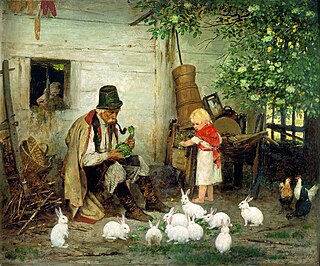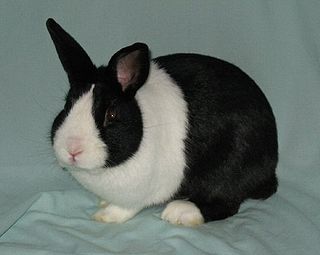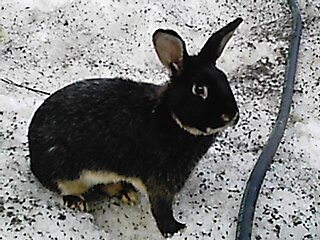Related Research Articles

Cuniculture is the agricultural practice of breeding and raising domestic rabbits as livestock for their meat, fur, or wool. Cuniculture is also employed by rabbit fanciers and hobbyists in the development and betterment of rabbit breeds and the exhibition of those efforts. Scientists practice cuniculture in the use and management of rabbits as model organisms in research. Cuniculture has been practiced all over the world since at least the 5th century.

Palomino is a genetic color in horses, consisting of a gold coat and white mane and tail; the degree of whiteness can vary from bright white to yellow. The palomino color derived from the inter-breeding of Spanish horses with those from the United States. Genetically, the palomino color is created by a single allele of a dilution gene called the cream gene working on a "red" (chestnut) base coat. Palomino is created by a genetic mechanism of incomplete dominance, hence it is not considered true-breeding. However, most color breed registries that record palomino horses were founded before equine coat color genetics were understood as well as they are today, therefore the standard definition of a palomino is based on the visible coat color, not heritability nor the underlying presence of the dilution gene.

The Angora rabbit, one of the most ancient groups of domestic rabbit breeds, which is bred for the long fibers of its coat, known as Angora wool. They are gathered by shearing, combing or plucking. Because rabbits do not possess the same allergy-causing qualities as many other animals, their wool is an important alternative. There are at least 11 distinct breeds of Angora rabbit, four of which are currently recognized by the American Rabbit Breeders Association (ARBA): the English Angora, the French Angora, the Giant Angora and the Satin Angora. Other unrecognized breeds include the German Angora, the Finnish Angora, the Chinese Angora, the Japanese Angora, the Korean Angora, the Russian Angora, the St Lucian Angora and the Swiss Angora.

Brown hair, also referred to as brunette, is the second-most common human hair color, after black hair. It varies from light brown to dark hair. It is characterized by higher levels of the dark pigment eumelanin and lower levels of the pale pigment pheomelanin.

The Coton de Tuléar is a breed of small dog named for the city of Tuléar in Madagascar. This breed is thought to have originated from a group of small white dogs that swam across the Malagasy channel following a shipwreck. Known for its cotton-like coat, the Coton de Tuléar typically grows to no more than 18 pounds (8.2 kg), and is white, sometimes with grey, tan, black, or tri-colored markings.
Chestnut or castaneous is a colour, a medium reddish shade of brown, and is named after the nut of the chestnut tree. An alternate name for the colour is badious.

The domestic rabbit is the domesticated form of the European rabbit, a member of the lagomorph order. A male rabbit is known as a buck, a female as a doe, and a young rabbit as a kit. There are hundreds of rabbit breeds, originating from all over the world.

The Dutch rabbit, historically known as Hollander or Brabander, is a breed of domestic rabbit. It is easily identifiable by its characteristic color pattern and was once the most popular of all rabbit breeds. However, after dwarf rabbits were developed, the popularity of the Dutch rabbit declined. Nevertheless, the Dutch rabbit remains one of the top ten most popular breeds worldwide.

The Mini Lop is a breed of domestic rabbit that is recognized by the American Rabbit Breeders Association (ARBA). It is different from the Miniature Lop breed that is recognized by the British Rabbit Council (BRC). The Mini Lop [US] and the Miniature Lop [UK] are different from the Dwarf Lop breed that is recognized by the BRC. The Mini Lop is similar to several other small rabbit breeds, such as the Dwarf rabbit.

The Holland Lop is a breed of lop-eared rabbit that was recognized by the American Rabbit Breeders Association (ARBA) in 1979. The Holland Lop, with a maximum weight of 1.8 kg (4 lb), is one of the smallest lop-eared breeds.

The Basset Bleu de Gascogne, also known as the Blue Gascony Basset, is a long-backed, short legged breed of dog of the hound type. A French native breed, it is rare outside its homeland. It is recognized internationally by the Fédération Cynologique Internationale, in the UK by The Kennel Club, and by the United Kennel Club in the United States. The "bleu" of its name is a reference to its coat which has a ticked appearance.

Mini Rex is a breed of domestic rabbit that was created in 1984 in Florida by the late Monna Berryhill of Texas. The Rex mutation, derived in France in the 19th century, is recessive and causes the hair to protrude outwards from the body, instead of lying flat, and the guard hairs to be shortened to the length of the undercoat, or a bit longer.

The Silver Marten is a breed of domestic rabbit. Although they are raised to compete in pet shows and agricultural shows, they are also regarded as "loveable and charming" pets.

The Argenté rabbit is one of the oldest breeds of French show rabbits. The British Rabbit Council (BRC) recognises six varieties: Argenté Bleu, Argenté Brun, Argenté Crème, Argenté de Champagne, Argenté Noir, and Argenté St Hubert. The American Rabbit Breeders Association (ARBA) recognises the Champagne d'Argent, the Crème d'Argent and the Argenté Brun. A rare variety, the Argenté Clair, is not currently recognised by either the BRC or ARBA.

Roan is a horse coat color pattern characterized by an even mixture of colored and white hairs on the body, while the head and "points"—lower legs, mane, and tail—are mostly solid-colored. Horses with roan coats have white hairs evenly intermingled throughout any other color. The head, legs, mane, and tail have fewer scattered white hairs or none at all. The roan pattern is dominantly inherited, and is found in many horse breeds. While the specific mutation responsible for roan has not been exactly identified, a DNA test can determine zygosity for roan in several breeds. True roan is always present at birth, though it may be hard to see until after the foal coat sheds out. The coat may lighten or darken from winter to summer, but unlike the gray coat color, which also begins with intermixed white and colored hairs, roans do not become progressively lighter in color as they age. The silvering effect of mixed white and colored hairs can create coats that look bluish or pinkish.

The New Zealand is a breed of rabbit, which despite the name, is American in origin. The breed originated in California, possibly from rabbits imported from New Zealand. New Zealand rabbits are available in five colors recognized by the American Rabbit Breeders' Association (ARBA): white, red, black, blue, and broken. Crossbreeding can result in many other variations, such as gold tipped steel and chestnut agouti. They average 10–12 lb (4.5–5.4 kg) with the does being slightly larger than the bucks. New Zealands are bred for meat, pelts, show, and laboratory uses, being the most commonly used breed of rabbit both for testing and meat production. They are also bred as pet rabbits but mostly breed for meat.
The Blue of Ham, also known as the Blue of Hem or Bleu de Ham, is a rare breed of domestic rabbit that originated in the Belgian village of Ham-sur-Heure. Developed as a meat and fur breed in 1897 by Ulysses Horemans, the once-popular Blue of Ham became rare following World War II. In 1967, a breeder named Delbusaye recreated the Blue of Ham using the Vienna breed, the Blue of Sint-Niklaas, and the Flemish Giant. Three years later, a standard for the new Blue of Ham was established, and in 1977 the breed was accepted again for exhibition. Today, the Blue of Ham is considered very rare.

The Thuringer is a breed of rabbit. It was originally known as the Thuringer Chamois due to having fur resembling that of the Chamois. They can be used for meat and fur, but make docile pets.
References
- 1 2 "Brun Marron de Lorraine ("Brown Chestnut of Lorraine")". FFC Fédération Française de Cuniculiculture ("French Federation for Cuniculture") (in French). 26 January 2010. Archived from the original on 6 March 2018. Retrieved 5 March 2018.
- ↑ Brown, Meg; Richardson, Virginia (1 April 2002). Rabbitlopaedia: A Complete Guide to Rabbit Care (pbk ed.). Ringpress Books Ltd. p. 119. ISBN 978-1860541827.